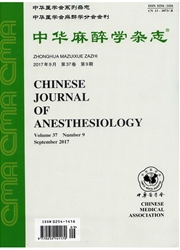

 中文摘要:
中文摘要:
目的评价环孢霉素A对大鼠神经病理性痛的效应。方法清洁级雄性sD大鼠40只,8周龄,体重250~300g。随机分为4组(n=10):C1组、C2组、CsA1组和CsA2组。采用坐骨神经慢性压迫性损伤(CCI)的方法制备大鼠神经病理性痛模型。C1组和CsA1组测定基础热痛阈和机械痛阈后,分别腹腔注射生理盐水2ml和环孢霉素A6mg/kg,1次,d,连续给药18d,于给药第6天时制备神经病理性痛模型,于CCI前1d、CCI后第1、3、4、6、8、10和13天(TⅠ~Ⅱ)时测定热痛阈和机械痛阈;C2组和CsA2组于测定基础热痛阈和机械痛阚后制备神经病理性痛模型,于CCI后第4~24天分别腹腔注射生理盐水2ml和环孢霉素A6mg/kg,1次/d,于CCI后第3、4、6、8、10、13、17和24天(L。)测定热痛阈和机械痛阈。结果与C1组比较,CsA1组T2-Ⅱ时热痛阈升高(P〈0.05),机械痛阈差异无统计学意义(P〉0.05);与C2组比较,CsA2组T13-16时热痛阈升高,T16时机械痛阈升高(P〈0.05)。结论环孢霉素A对大鼠神经病理性痛有一定程度的防治作用。
 英文摘要:
英文摘要:
Objective To investigate the effect of ciclosporin A (CsA) on neuropathic pain. Methods Forty male 8-week old SD rats weighing 250-300 g were used in this study. Neuropathic pain was produced by chronic constrictive injury (CCI) in all 40 animals. The sciatic nerve of right hind leg was exposed at the thigh level and 4 ligatures were placed at 1 mm intervals with 4-0 chromic catgut. The experiment was performed in two parts. In part Ⅰ ,20 rats were randomly divided into 2 groups ( n = 10 each) : group CsA1 received intraperitoneal (IP) CsA 6 mg/kg in normal saline (NS) 2 ml once a day for 18 consecutive days. The control group (C1) received NS 2 ml instead of CsA. CCI was performed on the 6 th day of CsA/NS administration in both group CsA1 and C1. In part Ⅱ , 20 rats were randomly divided into 2 groups ( n = 10 each) : CsA2 group received IP CsA 6 mg/kg in NS 2 ml once a day for 20 days. CCI was performed 4 days before CsA administration. The control group (C2) received NS 2 ml instead of CsA. Paw-withdrawal (P-W)threshold to noxious heat and mechanical (yon Frey hair) stimulation were measured before CCI and CsA administration (baseline), before and every 2-3 days after CCI for 2-3 weeks. Results The P-W threshold to mechanical stimulation was significantly decreased after CCI in all the 4 groups and was not increased by CsA administration and there was no significant difference between group C1 and CsA1 as well as group C2 and CsA2 . P-W threshold to heat stimulation remained unchanged after CCI in group CsAj and was significantly higher than in control group (C1). In CsA2 group the P-W threshold to heat stimulation was first decreased then gradually returned to pre-CCI level and was significantly higher than in group C2. Conclusion CsA given before CCI can prevent CCI-induced hyperalgesia to noxious thermal stimuli. CsA given after CCI can also relieve hyperalgesia to thermal stimuli induced by CCI. Mechanical hyperalgesia induced by CCI is not affected
 同期刊论文项目
同期刊论文项目
 同项目期刊论文
同项目期刊论文
 期刊信息
期刊信息
